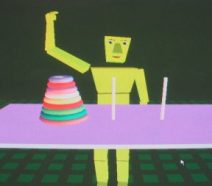Computers with Attitude
Researchers are trying to design computers that can recognize how you're feeling and react to help you out.
By Emily Sohn
It’s been a long day at school. You’ve got a heavy evening of homework ahead. You switch on your computer to work on an assignment. An animated kid on your computer screen smiles and says, “Hey, it’s good to see you again. But you look tired. Are you doing OK?”
You reply that you’re feeling pretty wiped out, but you’ve got a research project to do. You rub your eyes and yawn. “I know the feeling,” your computer-kid replies, blinking and sighing. “But don’t worry. We’ll get through it together in no time.”
 |
|
A computer that senses your feelings might make a useful learning companion. |
If a friendly, caring computer like this sounds far-fetched to you, think again.
Computer scientists and engineers are busy trying to design computers that can recognize how you’re feeling. The computers would then offer help or just a little friendly company while you work or play.
But it may be years before you’ll have a computer that can tell when you’re bored and responds by telling you a joke. Or a computer that cheers you on and gives you hints when you’re feeling frustrated with a math problem.
Keyboard or mouse
Think about how you interact with your computer now. You can type on a keyboard or click a mouse. Maybe you can also pound on a joypad, press on a touch screen, or even speak into a microphone.
The computer has no idea when you’re frustrated with it. It can’t tell whether you’re bored or entertained. When it comes to how you’re feeling, your computer hasn’t got a clue.
This severely limits a computer’s ability to help you, says Winslow Burleson. He’s a student at the Massachusetts Institute of Technology (MIT).
Burleson is one of many computer scientists who predict that computers someday will recognize human emotions and respond to them.
This idea belongs to a field in computer science known as “sensitive computing” or “affective computing.” The word “affective” refers to anything related to emotions.
Computer buddies
For a computer to sense your feelings, it needs more input than just your stroke on a keyboard or your movement of a mouse. Ideally, an affective computer would hear, see, and even touch its users, says computer scientist Rosalind Picard.
Such a computer needs sensors, such as cameras and microphones. It must then interpret what it senses. What does a smile or frown mean? How does your tone of voice suggest whether you’re excited, angry, or bored?
At MIT’s Affective Computing Lab, Picard and her students are building several systems that can do some of these things. One is called the Learning Companion. It’s a software buddy that can be added to educational programs, such as quizzes and lessons.
The Learning Companion generates an animated character—a kid—on the computer screen. The screen kid helps you out with whatever problem you’re working on.
 |
|
The Learning Companion asks which ring you would like to move in trying to solve a puzzle. The current version may look clunky, but as the Learning Companion becomes more advanced, its appearance will become more sophisticated—and more human. |
| Character system developed by Ken Perlin, New York University. |
“Right now, the character can smile, look at you, wave hello and good-bye,” Burleson says. “It can jump up and down in excitement or in a frustrated tantrum.”
Burleson predicts that, eventually, this virtual kid will use input from sensors to tell whether you’re paying attention. It’ll also respond to your changing mood as you work at the computer. It’ll know when to step in to help and when to stand by and let you keep working on your own.
A computer’s senses
The current version of the Learning Companion uses five different sensors to learn about a student sitting at a computer.
Two sensors are cameras. One camera focuses on your face, tracking changes that can show how you’re feeling. For example, are you biting your lip or laughing? The second camera tracks what you’re looking at to learn what’s holding your attention. It might be a something on the screen or a person on the other side of the room.
The computer’s mouse has a pressure sensor. Clicking the mouse really hard or over and over again can be a sign of frustration, Burleson explains.
A skin sensor detects how much your hands are sweating. Sweaty palms may indicate anxiety. The fifth sensor checks your posture. Are you on the edge of your seat or slouching?
 |
|
Does a frown mean you’re frustrated or just puzzled? |
But here’s where things get complicated. A student’s posture by itself doesn’t necessarily indicate interest or boredom. Some kids slouch even when they’re engrossed in what they’re doing. And a frown doesn’t always mean frustration. For some kids, it might mean they’re just busy thinking about a puzzle.
You can usually tell how a friend is feeling by watching her face or listening to the tone of her voice. Evaluating a combination of signals automatically comes naturally to you. Teaching a computer to do the same thing is difficult. That’s what Burleson and his colleagues are working on.
Future companions
What might a Learning Companion of the future be like?
“A lot of things we see in science fiction might become available,” Burleson says. “There could be peer robots that play with you, enhancing your abilities and your creativity.”
Picard has suggested that computer games could monitor how scared you are and award extra points for brave game-play.
It’s not just computers that may become buddies. How about an MP3 player that senses when you’re feeling stressed and selects music to calm you down? Or a cell phone that knows you just got some great news and automatically dials your best friend’s number?
For Picard, the biggest question isn’t whether it’s possible for computers to do all these things. It’s whether people will be ready to deal with them when they do.
Will you?
Going Deeper:
Word Find: Computers with Attitude







